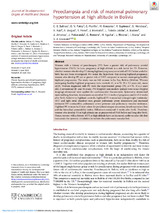Preeclampsia and risk of maternal pulmonary hypertension at high altitude in Bolivia

View/
Date
2023Author
Salinas, CE
Patey, OV
Murillo, C
Gonzales, M
Espinoza, V
Mendoza, S
Ruiz, R
Vargas, R
Perez, Y
Montaño, J
Toledo-Jaldin, L
Badner, A
Jimenez, J
Peñaranda, J
Romero, C
Aguilar, M
Riveros, L
Arana, I
Giussani, DA
Metadata
Show full item recordAbstract
Abstract.
Women with a history of preeclampsia (PE) have a greater risk of pulmonary arterial hypertension (PAH). In turn, pregnancy at high altitude is a risk factor for PE. However, whether women who develop PE during highland pregnancy are at risk of PAH before and after birth has not been investigated. We tested the hypothesis that during highland pregnancy, women who develop PE are at greater risk of PAH compared to women undergoing healthy highland pregnancies. The study was on 140 women in La Paz, Bolivia (3640m). Women undergoing healthy highland pregnancy were controls (C, n = 70; 29 ± 3.3 years old, mean±SD). Women diagnosed with PE were the experimental group (PE, n = 70, 31 ± 2 years old). Conventional (B- and M-mode, PW Doppler) and modern (pulsed wave tissue Doppler imaging) ultrasound were applied for cardiovascular íííassessment. Spirometry determined maternal lung function. Assessments occurred at 35 ± 4 weeks of pregnancy and 6 ± 0.3 weeks after birth. Relative to highland controls, highland PE women had enlarged right ventricular (RV) and right atrial chamber sizes, greater pulmonary artery dimensions and increased estimated RV contractility, pulmonary artery pressure and pulmonary vascular resistance. Highland PE women had lower values for peripheral oxygen saturation, forced expiratory flow and the bronchial permeability index. Differences remained 6 weeks after birth. Therefore, women who develop PE at high altitude are at greater risk of PAH before and long after birth. Hence, women with a history of PE at high altitude have an increased cardiovascular risk that transcends the systemic circulation to include the pulmonary vascular bed.
